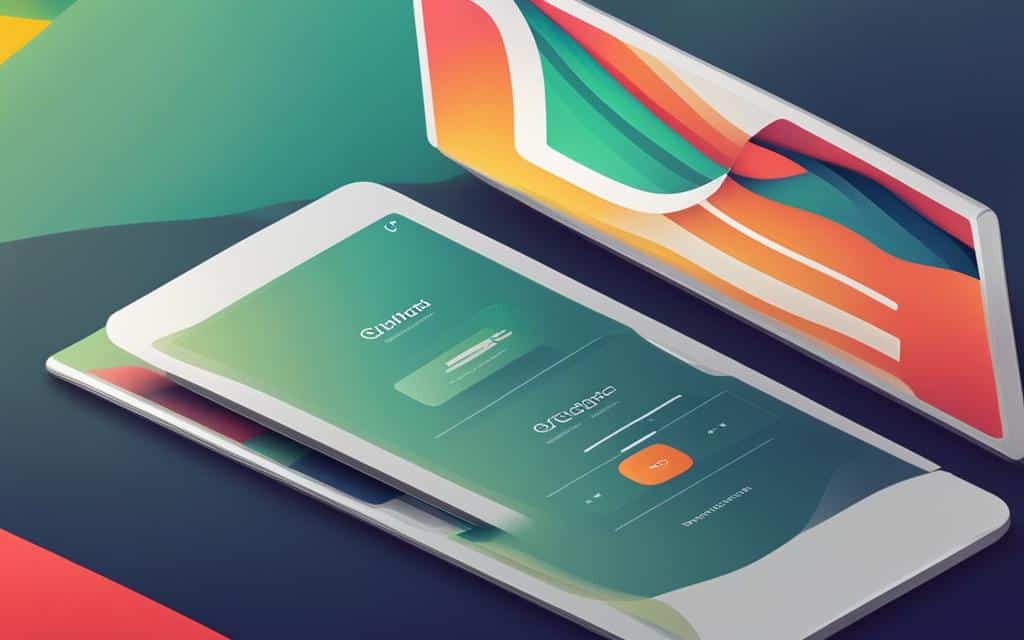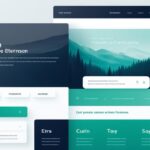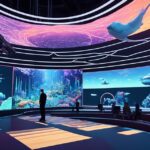Table of Contents
Animation in website design can elevate user experience by providing interactive and engaging elements. It can guide users, draw their attention to important content, and make navigation more intuitive. By incorporating web navigation animation, websites can improve user experience, creating an interactive and engaging website.
However, it’s important to use animation strategically and avoid overwhelming the audience. Excessive animation can lead to a cluttered user experience and hinder navigation. To ensure a positive user experience, it is crucial to strike a balance between animation and content, focusing on simplicity and clarity.
Optimizing animation for website load time is also important. Slow-loading animations can negatively impact user experience and increase bounce rates. By implementing animation optimization techniques, such as optimizing image and video formats, implementing lazy loading, and minimizing JavaScript usage, websites can maintain fast loading times and provide a seamless user experience.
In conclusion, incorporating animation into web design can greatly improve web navigation and enhance the overall user experience. When used strategically and optimized correctly, animation can make websites interactive and engaging, resulting in improved user satisfaction and increased time spent on the site. By following best practices and focusing on SEO-friendly animation techniques, websites can achieve higher search engine rankings and attract more organic traffic.
The Benefits of Hover Effects in Web Design
Hover effects in web design provide valuable visual feedback and enhance the overall user experience. When a user hovers over a button or link on a webpage, hover effects can be implemented to change the color, appearance, or animation of the element, indicating its interactive nature. By incorporating these effects thoughtfully, web designers can make navigation more intuitive and guide users seamlessly through the website.
Hover effects offer several benefits, such as:
- Visual Feedback: By changing the appearance of buttons or links upon hovering, hover effects provide immediate visual feedback to users, confirming their interaction with the element. This feedback reassures users that their actions are being registered and encourages further exploration of the website.
- Intuitive Navigation: Thoughtfully designed hover effects can improve the intuitive nature of web navigation. For example, changing the color of a button when hovered over can signify that it is clickable, leading users to the next step or information. This ensures that users can easily understand the interactive elements on the webpage and navigate without confusion.
“Hover effects provide visual feedback and guide users through a website, enhancing the overall user experience.”
Implementing hover effects also adds an element of interactivity and engagement to web design. When users encounter dynamic and responsive elements, they are more likely to stay engaged and explore further. This can lead to increased user retention, prolonged website visits, and ultimately, improved conversion rates.
Here is an example of a hover effect in action:
“`
“`
Example Hover Effect:
| Before Hover | After Hover |
|---|---|
As shown in the example above, the button’s color changes upon hovering, providing visual feedback to users and indicating its interactive nature. This simple yet effective hover effect can significantly enhance the user experience and improve the overall usability of the website.
In conclusion, hover effects play a crucial role in web design by providing visual feedback, improving intuitive navigation, and boosting user engagement. By strategically implementing hover animations, web designers can create interactive and engaging websites that deliver a seamless and enjoyable user experience.
Using Animation as a Guide in Complex Applications
Animation can play a crucial role in helping users navigate through complex applications or websites that contain a significant amount of content. By strategically incorporating animations, designers can highlight where users should start and draw attention to important information, ultimately improving user understanding and reducing the learning curve.
In complex applications, users often face challenges in comprehending the app’s functionality due to its intricate nature. Animation can effectively address this issue by providing visual cues and guiding users through the various features and processes. By visually connecting different elements and demonstrating their relationships, animation enhances usability and simplifies the overall user experience.
The Power of Animation
When utilized as a guide, animation serves as a powerful tool for improving user understanding. It can:
- Highlight key features and functionalities
- Indicate the logical flow of information
- Provide visual feedback on user actions
- Reveal hidden or expanding content
- Showcase data transitions and transformations
By leveraging these animation techniques, designers can create intuitive interfaces that guide users seamlessly throughout the application. This not only enhances user comprehension but also increases engagement and overall satisfaction.
“Animation can simplify the complexity of a user interface and contribute to a positive user experience, making it easier for users to navigate and comprehend complex applications.” – UX Designer, Emily Johnson
Building User Understanding
Thoughtful animation implementations go beyond simply adding visual appeal. They serve as an informative guide, ensuring users can easily grasp the functionality and purpose of various elements within the application.
Through animation, designers can:
- Trigger animations to demonstrate cause and effect
- Reveal step-by-step processes or sequential interactions
- Guide users through intricate navigation paths
These techniques provide users with clear visual cues, enhancing their understanding and confidence while interacting with the application.
Case Study: Animation in a Project Management Application
To illustrate the impact of animation as a guide in complex applications, consider a project management application. In such an application, animation can be employed to:
- Highlight key project milestones and critical tasks
- Visually demonstrate task dependencies and relationships
- Reveal progress updates and changes in project status
- Guide users through complex project hierarchies
| Animation Use Case | Benefits |
|---|---|
| Highlighting project milestones | Increases user awareness of crucial project stages |
| Visualizing task dependencies | Helps users understand the flow and order of tasks |
| Revealing progress updates | Keeps users informed about project advancements |
| Guiding through project hierarchies | Allows users to navigate complex project structures effortlessly |
As demonstrated in the table above, animation in a project management application assists users in comprehending complex project structures, enabling better decision-making and smoother project execution.
By leveraging animation as a guide in complex applications, designers can significantly improve user understanding and the overall user experience. Strategic animations enhance the intuitiveness of the application, reducing cognitive load and enabling users to navigate through even the most intricate interfaces with ease.
Striking the Right Balance Between Animation and Content
When it comes to incorporating animation into web design, finding the right balance between animation and content is crucial. While animation can enhance user experience and make websites more engaging, going overboard with animations can have the opposite effect, resulting in a cluttered and confusing user experience.
The key to creating a positive user experience is simplicity and clarity. Users should be able to navigate through a website with ease, without being overwhelmed by excessive animation. By focusing on providing a clear and streamlined user journey, you can ensure that users have a seamless and enjoyable experience on your website.
One of the best approaches to striking the right balance is to use animation selectively and purposefully. Identify the areas of your website where animation can add value and enhance the user experience. This could include guiding users through complex processes, highlighting important information, or adding visual interest to key elements.
Consider the impact of animation on user understanding and engagement. Ask yourself how each animation contributes to the overall user experience and whether it adds value or simply distracts. Remember, simplicity and clarity should always be the top priorities.
“Simplicity is the key to brilliance.” – Bruce Lee
By focusing on simplicity and clarity, you can create a website that is not only visually appealing but also easy to navigate and understand. This will result in a positive user experience and keep visitors engaged and interested in your content.
To illustrate the importance of balance in animation, let’s take a look at the following table:
| Website A | Website B |
|---|---|
| Overwhelming use of animations | Minimal and purposeful animations |
| Cluttered and confusing user experience | Clean and intuitive user experience |
| Distracts from the main content | Enhances the main content |
| Slow website loading time | Optimized website performance |
In this example, Website A goes overboard with animations, resulting in a cluttered and confusing user experience. On the other hand, Website B strikes the right balance by using minimal and purposeful animations, enhancing the main content without overwhelming the user. This table clearly demonstrates the importance of finding the right balance between animation and content.
Key takeaways:
- Strive for simplicity and clarity in your website’s design and navigation.
- Use animation selectively and purposefully to enhance the user experience.
- Avoid overwhelming the audience with excessive animation.
- Focus on providing a clear and streamlined user journey.
- Optimize animations for website load time to avoid performance issues.
Optimizing Animation for Website Load Time
While animations can enhance the user experience, they can also impact website load time if not optimized properly. It is crucial to implement SEO-friendly practices to ensure animations do not slow down page loading. By following these animation optimization techniques, you can maintain a positive user experience and improve search engine rankings.
Optimize Image and Video Formats
One of the key steps in optimizing animations is to optimize image and video formats. Compressing images and videos can significantly reduce their file size, leading to faster load times. Use appropriate image and video formats that strike a balance between quality and file size. SVG and WebM formats are recommended for animations due to their smaller file sizes.
Implement Lazy Loading
Implementing lazy loading for animations that are not immediately visible can greatly improve website load time. Lazy loading ensures that animations are only loaded when they become visible to the user. This approach reduces the initial loading time of the webpage and allows animations to load gradually as the user scrolls or interacts with the page.
Minimize JavaScript Usage
Excessive use of JavaScript can increase website load time and negatively impact performance. Minimizing the use of JavaScript in animations can significantly improve load times. Instead, consider using CSS transitions and transforms, which are often more performant and can achieve similar animation effects without the overhead of JavaScript.
Thoroughly Test across Devices
When optimizing animations for website load time, it is crucial to thoroughly test across devices. Animations may perform differently on various devices and browsers, so it’s important to ensure a consistent experience for all users. Conduct comprehensive testing to identify any performance bottlenecks and address them to optimize load times.
To summarize, optimizing animation for website load time is essential for maintaining a positive user experience and improving search engine rankings. By optimizing image and video formats, implementing lazy loading, minimizing JavaScript usage, and conducting thorough testing, you can ensure that animations enhance rather than hinder website performance.
When it comes to animated navigation, clarity and ease of use are paramount. Users should be able to navigate between different sections of a website effortlessly, following straightforward navigation paths. To achieve this, it is essential to employ best practices that incorporate visual cues and animation effects.
Visual cues in animated navigation guide users through the navigation process, indicating their current location on the site and providing clear directions on how to return to previous pages or access other sections. These cues can take the form of animated buttons, menus that expand or slide into view, or subtle color changes to signify navigation options.
By combining clear navigation paths with visual cues and animation effects, website owners can create a more intuitive and engaging user experience. Users will feel more confident and have a better understanding of how to navigate the site, resulting in increased user satisfaction and improved conversion rates.
Responsive design is a crucial component of animated navigation best practices. With the proliferation of mobile devices, it is essential to ensure that animated navigation works seamlessly across all platforms. A responsive design will provide a consistent and enjoyable user experience, regardless of the device being used.
Implementing these best practices will not only enhance user experience but also contribute to improved search engine rankings. Clear navigation paths and visual cues make it easier for search engine crawlers to understand the structure and content of the website, leading to better visibility in search results.
- Keep navigation paths straightforward and intuitive
- Use visual cues such as animated buttons or sliding menus
- Ensure responsive design for a consistent user experience across devices
- Optimize navigation animations for website loading speed
- Follow SEO-friendly practices to enhance search engine visibility
To illustrate the importance of animated navigation best practices, consider the following example:
| Website A | Website B |
|---|---|
|
|
In this example, Website B follows best practices for animated navigation, resulting in a more user-friendly experience compared to Website A. By implementing clear navigation paths, visual cues, and optimized loading animations, Website B attracts and retains users, ultimately leading to higher engagement and conversion rates.
By adhering to best practices for animated navigation, website owners can create a seamless user experience that enhances navigation, engages users, and improves overall website performance.
Conclusion
Animation in web design is a powerful tool that can greatly enhance user experience, making websites more engaging and interactive. When implemented strategically and thoughtfully, animation can guide users, improve content visibility, and enhance navigation.
However, it is crucial to strike the right balance between animation and content. The user experience should not be overwhelmed with excessive animations that distract from the main message. Simplicity and clarity should remain at the forefront of the design to ensure a positive user experience.
Optimizing animations for website load time is also essential. Slow loading pages can frustrate users and negatively impact search engine rankings. By optimizing image and video formats, implementing lazy loading, minimizing JavaScript usage, and conducting thorough testing, websites can maintain a seamless user experience without compromising performance.
Implementing SEO-friendly animation practices is key to improving search engine rankings. By following best practices and testing across devices, websites can ensure that animations positively contribute to the overall user experience while standing out in search engine results.
FAQ
Animation can elevate user experience by providing interactive and engaging elements that guide users, draw their attention to important content, and make navigation more intuitive.
What are hover effects and how do they impact web design?
Hover effects, such as changing the color or appearance of a button or link when the mouse cursor hovers over it, provide visual feedback to users and indicate interactive elements on a webpage. They can make navigation more intuitive, guide users, and enhance the overall user experience.
How can animation be used as a guide in complex applications?
Animation can serve as a valuable guide for users in complex applications or websites with a lot of content. By highlighting where to start or drawing attention to important information, animation can speed up user understanding of the app’s functionality and reduce the learning curve.
What is the recommended balance between animation and content?
It is crucial to strike the right balance between animation and content to provide a positive user experience. Going overboard with animations can lead to a cluttered and confusing user experience. Simplicity and clarity are key to ensuring a clear and streamlined user journey on your website.
How can animation be optimized for website load time?
To avoid slowing down page loading, animation should be optimized by optimizing image and video formats, implementing lazy loading for animations that are not immediately visible, minimizing JavaScript usage, and performing thorough testing across devices. Following these SEO-friendly animation practices will help maintain a positive user experience and improve search engine rankings.
Animated navigation should be clear and easy to use. It’s important to ensure that navigation paths are straightforward, allowing users to navigate between different sections of the website effortlessly. Providing visual cues and animation effects can guide users through the navigation process, indicating where they are on the site and how they can return to previous pages or access other sections. Responsive design is crucial for providing a consistent and enjoyable user experience across all platforms.
How can animation improve web design and search engine rankings?
Incorporating animation into web design can elevate user experience and make websites more engaging and interactive. When used strategically and thoughtfully, animation can guide users, enhance content, and improve navigation. By implementing SEO-friendly animation practices and testing across devices, websites can provide exceptional user experiences and stand out in search engine results.













